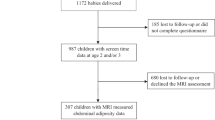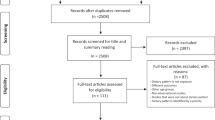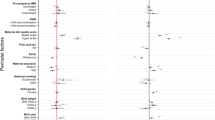Abstract
Data sources Databases searched included the International Database for Medical Research MEDLINE/Pubmed, ISI Web of Science, Scopus, Scientific Electronic Library Online (SciELO), and Latin American and Caribbean Health Sciences (LILACS).
Study selection Studies of observational design that examined the association between any screen-time behaviour and dietary intake in preschool and school-aged children (younger than 12 years) were selected by two independent reviewers. If a consensus could not be reached, a third reviewer was consulted.
Data extraction and synthesis Data were extracted independently by two reviewers using a pre-tested data extraction form. Risk of bias was assessed using an adapted version of the Newcastle-Ottawa Quality Assessment Scale for cross-sectional studies. A PRISMA flow chart was used to present the study selection results. The GRADE system was used to evaluate the strength of evidence. A qualitative synthesis was used to report the results. A meta-analysis was not conducted.
Results Nineteen studies were included in the review, all of which were of cross sectional design or conducted cross-sectional analysis. Fourteen studies were assessed as high quality, three as moderate quality and two as low quality. All studies found a significant positive association between television and/or total screen-time viewing and poor quality diet including lower intake of fruit and vegetables and higher intake of unhealthy foods. Screen-based sedentary behaviour was positively associated with cariogenic foods consumption in 15 studies. Based on the GRADE rating, there was moderate evidence of an association between TV viewing and intake of potentially cariogenic diet.
Conclusions Although there could be an association between TV viewing and poor quality cariogenic diet in preschool and school-aged children, the authors conclude that the strength of evidence is limited.
Commentary
Similar content being viewed by others
A Commentary on
Shqair A Q, Pauli L A, Costa V P P, Cenci M, Goettems M L.
Screen time, dietary patterns and intake of potentially cariogenic food in children: A systematic review. J Dent 2019; 86: 17-26. DOI: 10.1016/j.jdent.2019.06.004.

GRADE rating
Dental caries is among the most common non-communicable diseases (NCD) affecting children wordwide.1 Although there has been a dramatic improvement in the prevalence and severity of dental caries in the last four decades,2 it is still the case that considerable numbers of young children are referred to hospital for removal of carious teeth under general anaesthesia.3 Several studies and systematic reviews have investigated the association between caries and obesity4,5 because they may share a common pathway through dietary (that is, free sugar intake) and lifestyle behaviours.
The aim of this review was to examine the association between screen-time behaviour and diet in children younger than 12 years old. It included nineteen studies, the majority of which took place in EU countries. The participating children were aged 2-13 years. Sedentary and dietary behaviours were reported either by the participants or their parents, thus introducing the potential of response bias in the results.
The protocol of the review was registered with PROSPERO, and the PRISMA guidelines were used for the reporting. There was no restriction on publication date, but detailed information on whether there were any language restrictions is not provided. The review was limited only to online databases which consequently increases the risk of publication bias. Furthermore, the authors do not state whether experts were contacted to ensure that no relevant studies were missed. The outcomes and inclusion and exclusion criteria could have been more clearly defined. The study selection, data extraction and quality assessment were conducted independently by two reviewers. A list of excluded studies and the reason for their exclusion could have been provided. Further details on the included studies (for example, demographics) could have been considered, as this would allow examining the generalisability of findings to other settings. Although the authors report that meta-analysis was not possible, the review could have been improved by including summary measures of the association between the main variables and a statistical combination of results. Similarly, the authors could take account of the potential impact of quality assessment on the synthesis and interpretation of results. Taking into account the hierarchical level of evidence, the inclusion of only observational studies limits the ability to infer causality. A review of randomised controlled trials could have provided stronger evidence on a causal link between sedentary behaviour and cariogenic diets.
The review provides evidence, albeit limited, that sedentary behaviour, particularly TV viewing, is positively associated with potentially cariogenic diets in preschool and school-aged children. The association between sugar consumption with caries and other NCD is well established. Yet, the rise of overweight and obesity in the paediatric population alongside the high number of children admitted to hospital for removal of carious teeth under general anaesthetic are of particular public health concern in the UK. Therefore, a common risk factor approach appears to be the most prudent way forward: by targeting some common risk factors, a beneficial effect on a number of diseases can be achieved with greater efficiency and effectiveness and at lower cost.6 Systematic reviews synthesising the results of randomised controlled trials could help establish the direction of the relationship between screen time and cariogenic diets and determine whether the relationship is causal.
References
FDI World Dental Federation. The Challenge of Oral Disease - A call for global action. Geneva: FDI World Dental Federation, 2015.
Frencken J E, Sharma P, Stenhouse L, Green D, Laverty D, Dietrich T. Global epidemiology of dental caries and severe periodontitis - a comprehensive review. J Clin Periodontol 2017; 44: S94-S105.
Public Health England. Hospital tooth extractions of 0 to 19 year olds. London: Public Health England, 2019.
Hayden C, Bowler J O, Chambers S et al. Obesity and dental caries in children: a systematic review and meta-analysis. Community Dent Oral Epidemiol 2013; 41: 289-308.
Paisi M, Kay E, Bennett C et al. Body mass index and dental caries in young people: a systematic review. BMC Paediatrics 2019; 19: 122.
Sheiham A, Watt R G. The common risk factor approach: a rational basis for promoting oral health. Community Dent Oral Epidemiol 2000; 28: 399-406.
Author information
Authors and Affiliations
Corresponding author
Rights and permissions
About this article
Cite this article
Paisi, M., Witton, R. & Plessas, A. Is there an association between children's screen use and cariogenic diet?. Evid Based Dent 20, 115–116 (2019). https://doi.org/10.1038/s41432-019-0064-z
Published:
Issue Date:
DOI: https://doi.org/10.1038/s41432-019-0064-z



